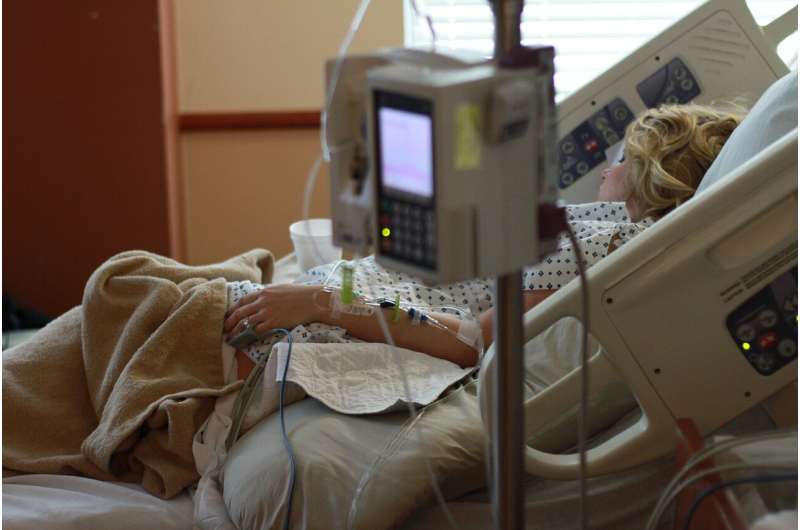This article has been reviewed according to Science X's editorial process and policies. Editors have highlighted the following attributes while ensuring the content's credibility:
fact-checked
trusted source
proofread
Keeping the noise down for ICU patients

New research by Edith Cowan University (ECU) and Fiona Stanley Hospital aims to decrease noise levels in intensive care units (ICUs) by implementing improvements in acoustic design.
Up to 50% of patients in ICUs experience sleep disturbance due to noise which can hinder recovery and negatively impact their health.
The study, by ECU Adjunct Senior Research Fellow Dr. Emil Jonescu and Director of ICU Research at Fiona Stanley Hospital Professor Ed Litton, was conducted at a 40-bed ICU in Fiona Stanley Hospital, Perth, and involved clinicians, medical practitioners, academics, and industry specialist consultants.
It investigated the impact of noise on patient sleep quality and clinician performance and provided practical recommendations for design approaches to noise mitigation.
The study, "Mitigating Intensive Care Unit Noise: Design-Led Modeling Solutions, Calculated Acoustic Outcomes, and Cost Implications," was published in HERD: Health Environments Research & Digital Design Journal.
The room acoustics analysis revealed that at times maximum noise levels in the ICU ranged from 60 to 90 dB(A), surpassing the thresholds for sleep disruption outlined by the World Health Organization guidelines.
Dr. Jonescu said noise was primarily caused by alarms from medical equipment and discussions among clinical staff and was a common problem across all ICUs.
"In the ICU there are a lot of beeps and alarms from machines and some of that noise can't be mitigated because of the important information provided for clinicians," he said.
"Our aim was to try and find the optimal balance of good information flow for clinicians and rest and recovery for patients, and we found there are certainly some design improvements that can be made."
Professor Litton said that sleep disruption was a major issue raised by patients in intensive care and that problems with sleep could often persist after discharge, causing distress and creating a barrier to recovery.
"Thinking holistically about how we make the experience as comfortable as possible for patients while in intensive care is so important," he said.
"This means we need to collaborate broadly, including with design experts, to address the issues that matter for our patients."
Impact on staff
Part of the study investigated health professionals' perceptions of noise impact on patient sleep and staff duties in the ICU.
Staff reported ICU noise negatively impacted their work performance, patient connection and job satisfaction.
"They indicated that their biggest concern was the impact to patient sleep quality, however, they also believe a quieter ICU would improve clinicians thinking ability," Dr. Jonescu said.
"ICU Clinicians and patients share the same environment and it's clear that improvements in noise levels will benefit everyone."
Biggest gains come from reducing noise between rooms
Through a 3D modeling process, researchers simulated various acoustic treatment upgrades.
They found that room layout and equipment precluded many noise reduction options. These were limited to perimeter surface sound absorption, whereas direct transmission pathways, and volume settings offered potential for more significant noise reductions.
"One of the most significant findings of the study was that by concentrating on noise reduction strategies for the partition walls between patient rooms, transference of noise from room to room can be significantly reduced," Dr. Jonescu said.
"The findings showed a significant reduction of 14 decibels with the doors between rooms in the open position."
Further research
Dr. Jonescu said the study identified potential for medical equipment designers to consider alarm speakers' directivity focusing the sound toward sound-absorbing wall finishes and reducing noise exposure toward patients.
"Future research could also explore the minimum volume level that machines can operate at where there is no impact to clinicians' ability to do their work," he said.
"A reduction in volume from the default 100% maximum could have massive impact in reducing overall noise, and it wouldn't cost anything."
More information: Emil E. Jonescu et al, Mitigating Intensive Care Unit Noise: Design-Led Modeling Solutions, Calculated Acoustic Outcomes, and Cost Implications, HERD: Health Environments Research & Design Journal (2024). DOI: 10.1177/19375867241237501

















